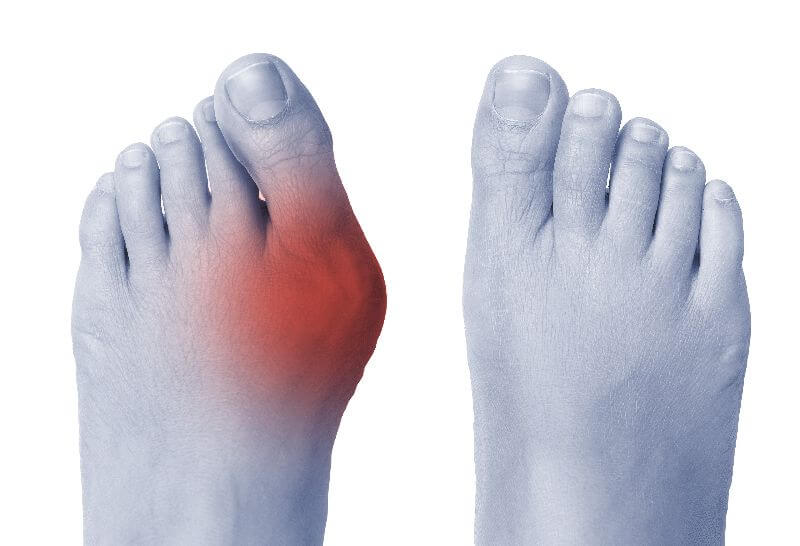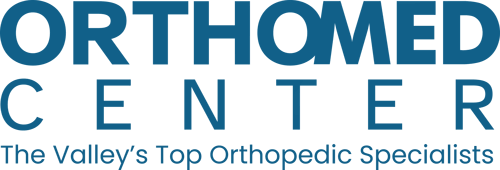Bunions are one of the most common conditions that affect the feet. They are a deformity at the base of the big toe. They cause pain and discomfort and may get worse over time without treatment. Bunions can only be corrected with surgery, but we also offer nonsurgical treatment options to help alleviate pain and discomfort.
Bunions are deformities that occur when the first long bone in the foot (called the metatarsal) moves out of place, causing the big toe to lean towards the second toe. This shift causes a bump to form at the base of the big toe, forming the characteristic bunion bump.
Bunions can be painful and cause discomfort, but there are several treatment options available.
Genetics and choice of footwear contribute to the formation of bunions.
Bunions are thought to have a genetic component, including the laxity of the joints or poorly formed or abnormal collagen. In some cases, bunions develop in children due to a genetic predisposition to this foot deformity.
Bunions are more common in women than in men. Footwear is generally thought to be the biggest reason for this.
Tight, ill-fitting, narrow, and high-heeled shoes increase the likelihood of developing bunions. Any shoe that forces the toes to crowd into the front of the shoe is likely to contribute to bunion development. Orthopedic surgeons typically recommend the ideal heel height for footwear to be less than 1.5 inches.
Without proper treatment, bunions tend to worsen over time. As the bunion becomes larger, it becomes more painful and may lead to additional problems. Bunions may lead to bursitis, an inflammation of the fluid-filled sac that cushions the joint. A worsening bunion can cause the big toe to angle further inward and lead to misalignment of the second toe, resulting in a painful hammertoe.
At OrthoMed, we offer both nonsurgical and surgical treatment options for bunion treatment.
Initial treatment for a bunion is generally nonsurgical. We recommend that patients wear wider shoes and have heels that are less than 1.5 inches high to avoid further irritation of the bunion. Anti-inflammatory medications may be recommended if the bunion is painful. Orthotics have also proven to be helpful for patients in the early stages of bunion deformity.
While nonsurgical treatment cannot correct a bunion deformity, it can help reduce pain and prevent further progression of the deformity. If a patient continues to experience pain or the bunion deformity worsens, surgery is often recommended.
There are a variety of surgical techniques that can be used to correct a bunion deformity. Most techniques involve repositioning the big toe to relieve pain and improve function.
Your orthopedic foot and ankle surgeon will choose the best surgical technique for you based on the severity of the bunion. Bunion deformities are categorized as mild, moderate, or severe.
For a mild bunion deformity, distal procedures are often recommended. These procedures involve using a wire or screw to stabilize and straighten the joint. A soft tissue procedure is usually performed alongside the distal procedure to tighten any loose tissues or lengthen tight tissues, helping to correct imbalance in the joint.
Moderate and severe bunion deformities require more extensive surgical treatment. In these cases, a proximal osteotomy or fusion is often performed. An osteotomy involves making small cuts in the bone to realign and straighten the joint. Osteotomies may be performed in several places to achieve proper alignment. Pins, screws, or plates are used to fix the bones in place. A soft tissue procedure may also be done to help maintain proper alignment of the joint.
At OrthoMed, we work diligently with our patients to maximize outcomes for full recovery from bunion surgery. Recovery times vary based on the type of procedure performed.
Physical therapy may be recommended to restore strength and range of motion in the foot.
Possible complications of bunion surgery include stiffness and positional abnormalities in the big toe. The chance that a bunion can recur after surgery varies from 5% to 50%. To minimize the chance of recurrence, patients should avoid wearing tight, narrow shoes and high heels after bunion surgery.
Our board-certified orthopedic foot and ankle surgeon, Dr. Braaton, offers a full range of surgical and nonsurgical treatments for bunion relief. He is highly skilled in bunion treatment and is happy to help with all of your treatment needs. To schedule a consultation with Dr. Braaton, please call OrthoMed at
(209) 524-4438. You may also
request an appointment online.



